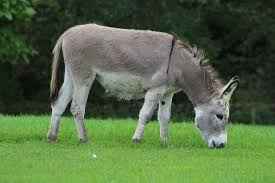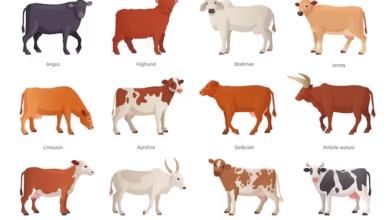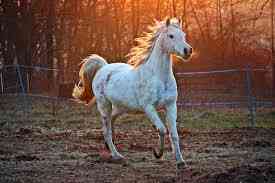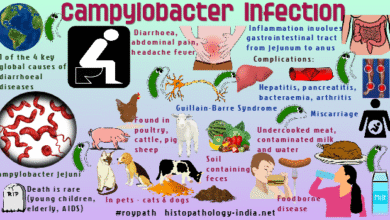Haemonchus contortus (parasites) in sheeps
1. Introduction to Haemonchus contortus in Sheep 2. Life Cycle of the Barber Pole Worm 3. How Sheep Become Infected 4. Clinical Signs and Symptoms of Infection 5. Anemia and Bottle Jaw: Key Indicators 6. Diagnostic Methods for Haemonchosis 7. FAMACHA Scoring and Its Importance 8. Treatment and Deworming Strategies 9. Preventive Measures and Pasture Management 10. Conclusion: Protecting Flocks from Haemonchus contortus
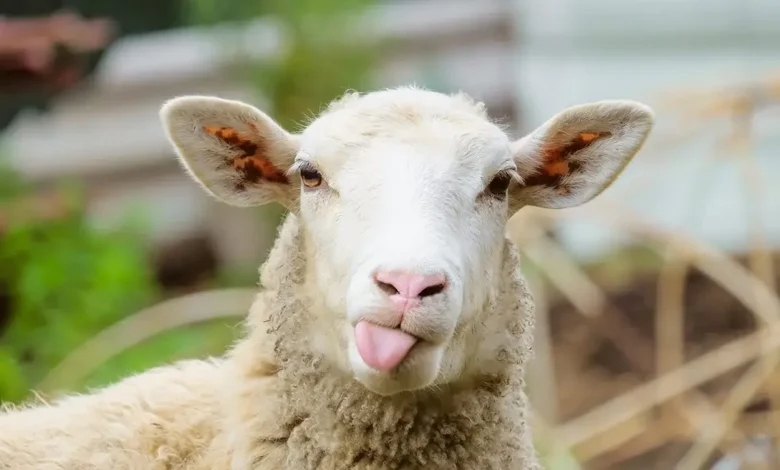
Haemonchus contortus, also known as the barber’s pole worm, is a blood-sucking gastrointestinal parasite that primarily infects the abomasum (true stomach) of sheep.
Abstract
A strong Th2-type immune response against Haemonchus contortus infection in genetically resistant sheep provide immunity. The objective of present study was to correlate mean faecal egg counts (FECs), absolute eosinophil counts and Th1/Th2 gene expression in resistant (R) and susceptible (S) Malpura sheep. In spite of no anthelmintic treatment in R line, on majority of the months, mean FECs remained significantly (P < 0.05) lower compared to S line where anthelmintic treatment was given in September every year. R sheep possess a smaller number of blood eosinophils in the majority of months as compared with S sheep and a positive correlation has been observed between absolute eosinophil counts and mean FEC. In the condition, when FEC remain similar in both the lines (R and S), significantly (P < 0.05) up-regulated expression of IL-5 was observed in R sheep compared with S sheep however when FEC is hugely enhanced; IL-2, IL-6, IL-12 and IL-13 gene expression was significantly (P < 0.05) up-regulated in R sheep as compared to S sheep which is dependent on season and parasite load.
Introduction
The livestock industry in India is vital to the country’s agricultural sector, particularly in the rural economy. Sheep products are an important source of livelihood for smallholder farmers and landless labourers in the low-rainfed region of the country. Recently, sheep rearing for the sale of live animals has grown significantly, particularly in meat-consuming southern states like Telangana, Andhra Pradesh and Karnataka. These three states are on top regarding the sheep population (BAHS, 2023). Estimates of the 20th livestock population census indicate a 14.13 % increase in sheep population compared with the previous census (BAHS, 2023). There are approx. 73.70 million sheep were slaughtered for meat purposes in 2022–23 with the corresponding number of 69.56 million heads in the previous year (2021−22). Morbidity caused by different pathogens significantly contributes to the decline in sheep production in terms of meat, wool and milk. One of the prominent diseases that causes this, is gastrointestinal nematode (GIN) infection. Sheep contracting infection from GIN constitutes an important contributor to economic losses for sheep production worldwide including India Mcrae et al., 2015).

Haemonchus contortus (Domain/Super kingdom: Eukaryota; Kingdom: Metazoa; Clade: Ecdysozoa; Phylum: Nematoda; Class: Chromadorea; Order: Rhabditida; Suborder: Rhabditina; Infraorder: Rhabditomorpha; Superfamily: Strongyloidea; Family: Trichostrongylidae; Genus: Haemonchus), an abomasal blood-sucking nematode of small ruminants with the highest prevalence in tropical climates (Carson et al., 2023), is considered one of the most pathogenic and economically important GIN infections in sheep (Saccareau et al., 2017; Toscano et al., 2018). The emergence and re-emergence of anthelmintics-resistant nematodes made selective breeding an integrating tool to limit GIN infection with profitable sheep husbandry (Pacheo et al., 2024). Adaptive immune responses of individual sheep against nematode infection strongly correlate with disease outcome. Genetic resistance to GIN infection in Romney sheep is associated with an increase in the Th2 arms of the immune system which mediate inflammatory responses against multicellular parasites (Shaw et al., 1999). Th2 arm of the host immune system plays crucial role in mediating host-resistance during helminth infections. It mediates expulsion of adult worms from the intestine by increased intestinal contractility, enhanced mucus production for barrier function and killing of parasitic larvae by macrophage activation. Th2 arm is characterized by production of IL-4, IL-5, IL-9, IL-13, IL-25 and IL-33 interleukins (McNeilly and Nisbet, 2014; Harris and Loke, 2017).
Haemonchus contortus infection in sheep

Strong Th2-type immune response to Haemonchus infection in genetically resistant sheep supports the claim for a Th1/Th2 dichotomy in ruminants (Gill et al., 2000). Perthaner et al. (Pernthaner et al., 2005; Pernthaner et al., 2006) demonstrated that increased expression of interleukin-5 (IL-5) and interleukin-13 (IL-13) genes in intestinal lymph cells of sheep selected for enhanced resistance to nematodes during infection with Trichostrigylus colubriformis. Parasite-resistant (R) sheep respond to parasites with an early up-regulation of Th2-type cytokines after nematode infection. Ovine cDNA microarray analysis of parasite resistant sheep revealed that genes highly expressed in R sheep belong to those responsible for maintaining a healthy immune system however in susceptible (S) sheep those related to the cellular response to stress (Keane et al., 2006).
Structure

The Major differences between R and S sheep were the rate at which an effector response develops rather than simply the intensity of the response (Ingham et al., 2008). Shakya et al. (2009) had also shown a Th2 type of immune response associated with increased resistance to H. contortus in naturally infected Gulf Coast sheep. Host genes implicated in parasite resistance mainly confer recognition of parasites and mount Th-2 immune response (Andronicos et al., 2010). Resistance to H. contortus in Corriedale sheep is associated with high parasite-specific IgA titer and a systemic Th2 immune response (Escribano et al., 2019). Neutrophils are implicated as a potential effector cell responsible for Th2 initiation during H. contortus infection in St. Croix (STC) sheep (Middleton et al., 2020); however, Scottish blackface sheep selected for parasite resistance demonstrated lack of a clear Th1/Th2 dichotomy.
Activated eosinophils, a hall mark of helminth infection
It can attack stages of helminths within tissue by releasing molecules that are cytotoxic to larvae (Rainbird et al., 1998; Balic et al., 2006). Eosinophils contribute both to initiation and effector functions of Th2 immunity (Spencer and Weller, 2010). It is an integral member of the gastrointestinal mucosal immune system considered as a defender (Huang and Appleton, 2016) and plays direct role in the effective control of H. contortus infection in sheep (Hernandez et al., 2020). The present study aimed to (i) evaluate and correlate mean faecal egg count (FEC) and absolute eosinophil count and (ii) evaluate Th1/Th2 gene expression in R and S Malpura sheep.
Selection of animals and feacal egg counts (FECs)
The study was conducted at ICAR-Central Sheep and Wool Research Institute, Avikanagar, India. All animal experiments were performed according to protocols approved by the institutional ethical committee for the use and care of animals at ICAR-Central Sheep and Wool Research Institute, Avikanagar, Rajasthan, India. A breeding program was initiated in 2004 to build divergent lines of Malpura sheep for resistance or susceptibility to H. contortus based on phenotypic marker-faecal egg count (FEC)

Conclusion
R sheep possess a smaller number of blood eosinophils in the majority of months as compared with S sheep and a positive correlation has been observed between absolute eosinophil counts and mean FEC. In the condition, when FEC remain similar in both the lines (R and S), significantly (P < 0.05) up-regulated expression of IL-5 was observed in R sheep compared with S sheep however when FEC is hugely enhanced.
Ethical statement
All animal experiments were performed according to protocols approved by the institutional committee for use and care of animals at ICAR- Central Sheep and Wool Research Institute, Avikanagar, Rajasthan, India. The work described has not been published previously except in the form of an abstract, or registered report. The article is not under consideration for publication elsewhere. The article’s publication is approved by all authors and tacitly or explicitly by the responsible authorities.
Diagnose
Diagnosis of Haemonchus contortus in Sheep
Haemonchus contortus, also known as the barber’s pole worm, is a blood-sucking gastrointestinal parasite that primarily infects the abomasum (true stomach) of sheep and goats. Accurate diagnosis is essential to manage and control this highly pathogenic parasite.

Some Diagnostic Methods
- FAMACHA System
- Assesses anemia by checking the color of the lower eyelid.
- Useful for field diagnosis of Haemonchus, which causes blood loss.
- Fecal Egg Count (FEC)
- Microscopic examination of feces for strongyle-type eggs.
- Quantifies egg count per gram (EPG) to estimate worm burden.
- Larval Culture and Differentiation
- Fecal samples are cultured to hatch larvae, then identified morphologically.
- Helps distinguish Haemonchus from other strongyle-type parasites.
- Post-Mortem Examination
- Adult worms visible in the abomasum during necropsy.
- Characteristic red and white “barber’s pole” appearance.
- PCR & ELISA (Advanced Methods)
- Molecular techniques detect parasite DNA or antigens.
- More precise but less accessible in field settings.
Clinical Signs
Pale mucous membranes (anemia)
Bottle jaw (edema under the jaw)
Lethargy, weight loss
Sudden death in severe infections

Haemonchus contortus causes severe anemia in sheep by feeding on blood in the abomasum (true stomach). This blood-sucking parasite can remove significant amounts of blood daily, leading to pale mucous membranes, weakness, and reduced productivity. In heavy infestations, sheep may develop “bottle jaw”—a fluid swelling under the jaw—due to protein loss and low blood albumin. If left untreated, the anemia can become fatal, especially in young or malnourished animals. Early detection and regular monitoring are crucial for preventing serious health impacts.

